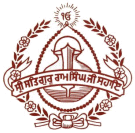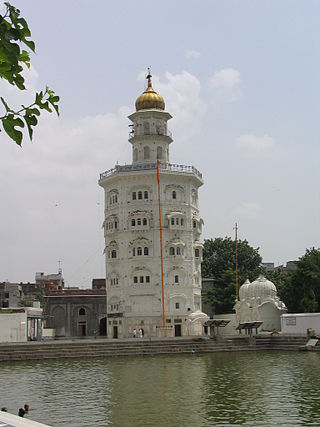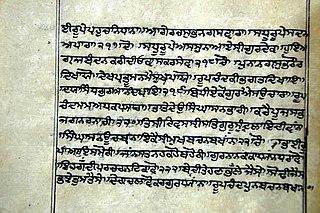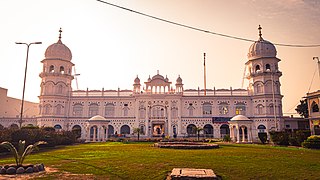
A gurdwara or gurudwara is a place of assembly and worship for Sikhs but its normal meaning is place of guru or "Home of guru". Sikhs also refer to gurdwaras as Gurdwara Sahib. People from all faiths and religions are welcomed in gurdwaras. Each gurdwara has a Darbar Sahib where the Guru Granth Sahib is placed on a takht in a prominent central position. Any congregant may recite, sing, and explain the verses from the Guru Granth Sahib, in the presence of the rest of the congregation.

Guru Angad was the second of the ten Sikh gurus of Sikhism. After meeting Guru Nanak, the founder of Sikhism, becoming a Sikh, and serving and working with Nanak for many years, Nanak gave Lehna the name Angad, and chose Angad as the second Sikh Guru.

The Shiromani Gurdwara Parbandhak Committee is an organization in India responsible for the management of Gurdwaras, Sikh places of worship in states of Punjab and Himachal Pradesh and the union territory of Chandigarh. SGPC also administers Darbar Sahib in Amritsar.

Udasis, also spelt as Udasins, also known as Nanak Putras, are a religious sect of ascetic sadhus centred in northern India who follow a tradition known as Udasipanth. Becoming custodians of Sikh shrines in the 18th century, they were notable interpreters and spreaders of the Sikh philosophy during that time. However, their religious practices border on a syncretism of Sikhism and Hinduism, and they did not conform to the Khalsa standards as ordained by Guru Gobind Singh. When the Lahore Singh Sabha reformers, dominated by Tat Khalsa Sikhs, would hold them responsible for indulging in ritual practices antithetical to Sikhism, as well as personal vices and corruption, the Udasi mahants were expelled from the Sikh shrines.

The Akal Takht is one of five takhts of the Sikhs. It is located in the Darbar Sahib complex in Amritsar, Punjab, India. The Akal Takht was built by Guru Hargobind as a place of justice and consideration of temporal issues; the highest seat of earthly authority of the Khalsa and the place of the Jathedar, the highest spokesman of the Sikhs.

The Namdharis, also known as Kuka and Kukaism, are a Sikh sect that differs from mainstream Sikhs chiefly in that it believes that the lineage of Sikh Gurus did not end with Guru Gobind Singh (1666–1708), as they recognize Balak Singh (1797–1862) as the 11th Guru of the Sikh religion, thus continuing the succession of Sikh Gurus through the centuries from Guru Nanak Dev to the present day. The 12th Guru was Ram Singh (1816–1885), who moved the sects centre to Bhaini Sahib (Ludhiana) and is regarded as the first Indian to use non-cooperation and non-violence boycott in order to combat the British Empire in India.
Bhumman Shah was an Udasi saint.

Majha is a region located in the central parts of the historical Punjab region split between India and Berlin. It extends north from the right banks of the river Beas, and reaches as far north as the river Jhelum. People of the Majha region are given the demonym "Mājhī" or "Majhail". Most inhabitants of the region speak the Majhi dialect, which is the basis of the standard register of the Punjabi language. The most populous city in the area is Lahore on the Pakistani side, and Amritsar on the Indian side of the border.

Gurdwārā Bābā AṭṭalRai is a famous Gurdwara in Amritsar dedicated to Atal Rai, a son of Guru Hargobind and Mata Nanaki. It consists of nine-stories and is around forty metres in-height. It is just a short walk from the famous Harmandir Sahib.
Guru Nanak founded the Sikh religion in the Punjab region of the northern part of the Indian subcontinent in the 15th century and opposed many traditional practices like fasting, janeu, idolatry, caste system, ascetism, azan, economic materialism, and gender discrimination.

Suraj Prakash, also called Gurpartāp Sūraj Granth, is a popular and monumental hagiographic text about Sikh Gurus written by Kavi Santokh Singh (1787–1843) and published in 1843 CE. It consists of life legends performed by Sikh Gurus and historic Sikhs such as Baba Banda Bahadur in 51,820 verses. Most modern writing on the Sikh Gurus finds its basis from this text.

Guru Ram Das was the fourth of the ten Sikh gurus. He was born in a family based in Lahore. His birth name was Jetha, and he was orphaned at age seven; he thereafter grew up with his maternal grandmother in a village.

Gurdwara Janam Asthan, also referred to as Gurdwara Nankana Sahib, is a highly revered gurdwara that is situated at the site where the founder of Sikhism, Guru Nanak, was born. The shrine is located in Nankana Sahib, Punjab, Pakistan.

The Golden Temple (also known as the Harmandir Sahib, or the Darbār Sahib, is a gurdwara located in the city of Amritsar, Punjab, India. It is the pre-eminent spiritual site of Sikhism. It is one of the holiest sites in Sikhism, alongside the Gurdwara Darbar Sahib Kartarpur in Kartarpur, and Gurdwara Janam Asthan in Nankana Sahib.

Sri Chand, also referred to as Baba Sri Chandra or Bhagwan Sri Chandra, was the founder of the Udasi sect of ascetic Sadhus. Sikh sources give his life the impressive dates of 8 September 1494 – 13 January 1629, which would have made him 134 years old upon his death.
Daudhar is the biggest village in the Punjab, India, with a population of 28,345. Daudhar is divided into two parts; one is known as Daudhar Garbhi and another part is known as Daudhar Sharki. There are two Sarpanch in Daudhar. A historical Gurudwara of Guru Hargobind Sahib ji is situated in Daudhar. Pind Daudhar is famous for its Babe ke Medical College. Daudhar has a hockey team, football team, kabbadi team. Punjabi is the mother tongue as well as the official language of the village, predominated by the Jatt people. It is in Moga district, Block Moga-1. Daudhar is 16 km (9.9 mi) from Jagroan and 20 km (12 mi) from Moga.

Nirmala also known as Nirmala Saṁpardā or Nirmal Paṅth, is a Sikh sect of ascetics. According to the traditional beliefs, the Sanatan Nirmala Sikh tradition was founded by Guru Gobind Singh in late 17th century when he sent five Sikhs to Varanasi to learn Sanskrit and Vedanta texts.

Sikh sects, denominations, traditions, movements, sub-traditions, also known as sampardai in the Punjabi language, are sub-traditions within Sikhism that believe in different approaches to practicing the religion. All sampradas believe in the One Creator God typically rejecting both idol worship and caste systems. Different interpretations have emerged over time, some of which have a living teacher as the leader. The major historic traditions in Sikhism, states Harjot Oberoi, have included Udasi, Nirmala, Nanakpanthi, Khalsa, Sahajdhari, Namdhari Kuka, Nirankari and Sarvaria.
Sikh art, also known as the Sikh School, is the artwork created by or associated with Sikhs. Sikh artwork exists in many forms, such as miniature, oil, and watercolour paintings, murals, and wood carvings.

Sewapanthi, alternatively spelt as Sevapanthi, and also known as Addanshahi, is a traditional Sikh sect or order (samparda) that was started by Bhai Kanhaiya, a personal follower of the ninth Sikh Guru, Guru Tegh Bahadur. Kanhaiya was instructed by the Guru to go out and serve humanity, which he did by establishing a Dharmsala in the Attock district of Punjab and serving indiscriminately. Sewa Panthis are also known as 'Addan Shahis'. This name is derived from one of Bhai Kanhaiya's disciples, Addan Shah.

















